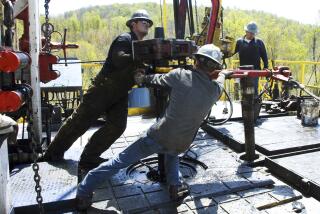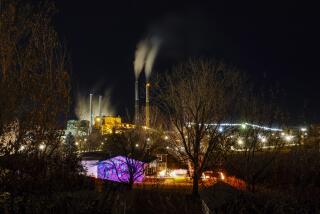‘When Oil Peaked’ argues for alternative energy sources — soon
Fans of John McPhee’s 1981 book “Basin and Range” will remember Kenneth S. Deffeyes, the longtime Princeton professor who helped guide the reader through what was then called the “New Geology.” “Deffeyes,” McPhee wrote, “is a big man with a tenured waistline. His hair flies behind him like Ludwig van Beethoven. He lectures in sneakers.”
Deffeyes doesn’t lecture anymore — he retired in 1998 — but his hair still tends to get unruly.
Likewise, the findings in Deffeyes’ latest book might cause oil executives — even those not affiliated with BP — to go gray overnight.
“When Oil Peaked” (FSG, 176 pp., $23), Deffeyes’ third book on the global oil supply, argues that oil production will never again reach the “peak” year of 2005, and that within as little as 100 years we’ll be relying almost entirely on energy that is “directly or indirectly solar: biomass, wind, hydroelectric, and waves.”
At the moment, this doesn’t seem so scary. A century from now? But the point, Deffeyes says, isn’t so much what happens in 2100 as what we do in the near future to bring other energy sources online as our oil supply dwindles.
Deffeyes, 78, has worked in and around the oil industry for more than half a century, and he has a strong track record. In his 2001 book “Hubbert’s Peak: The Impending World Oil Shortage,” he predicted that oil production would top out during the middle of the first decade of this century. It was only a prognostication then, but as he notes in his new book, “Currently, the U.S. Energy Information Agency shows 2005 as the peak year” for global oil production.
“The 2005 [prediction] has held up very strongly,” said Deffeyes, speaking from his home in San Diego, “and the current Department of Energy numbers still say that. They revise it every month.”
Deffeyes arrived at his prediction by employing and adapting the methodology of M. King Hubbert, a geophysicist whom he worked alongside at the Shell Oil research lab from the late 1950s to the early 1960s. In 1956 Hubbert used a set of intricate mathematical tools to forecast that the production of oil in the continental United States would peak within 15 years. He was right, which is why Deffeyes, in his new book, refers to Hubbert as “the patron saint of the peak-oil crowd.”
Of course, not everyone agrees that oil production is on an irreversible decline.
Michael C. Lynch, president of the Massachusetts-based consulting firm Strategic Energy and Economic Research, said in an interview that “the idea that [2005 is] the peak is kind of silly.”
Lynch recalled debating the issue with Deffeyes, and airing his concerns about Hubbert’s — and by extension, Deffeyes’ — methodology. “I said: ‘Look, if you use this equation on U.S. [gross domestic product], it also looks like we’re running out of GDP. Or auto production, or whatever. You will always get this kind of declining curve.”
He added, “There are already several million barrels a day of idle capacity, so if the demand was there [the 2005] amount could easily be surpassed.”
Deffeyes concedes that he’s not had much success in bringing his critics around to his way of thinking. “When I explain the idea [of peak oil] to somebody who’s never heard it, they think one of two things: ‘Oh sure, it’s going to be that way.’ Or: ‘Nope, never happen. Everybody’s been wrong so far, therefore you must be wrong too.’ And that means they think oil is going to last forever because we’ll never accept any argument that says” otherwise.
Last spring’s oil spill in the Gulf of Mexico is a complicating factor, of course. BP’s failures will likely make it more difficult for companies with relatively clean safety records to move ahead with deepwater drilling projects, Deffeyes said, meaning that another source of oil will be compromised.
All of which has Deffeyes convinced that the U.S. will be in trouble unless it moves toward other sources of energy. “We have to do something,” he said, “and not doing something is the worst thing of all.”
Natural gas is a particularly attractive option, Deffeyes writes, but one that presents “a chicken-and-egg problem. Although building a natural-gas-powered automobile costs no more than building a gasoline car, the automobile companies won’t market natural-gas cars because there are no filling stations. Nobody will build filling stations because there are no natural-gas cars. This is a situation where a governmental boost might get the ball rolling.”
Looking at his oil data through a broad economic prism, Deffeyes is less than sanguine.
“If I’m right about 2005,” he said, “we may never get out of this recession — that it’s just permanent because we’re losing a major feed into our economy, which is crude oil.
He added, “That’s what a president could get up and say: ‘Look, we don’t want to sit in this recession, we’ve got to get cranking on some kind of [energy-based] response, and we’ve got to admit that the 2005 thing is probably real.’ ”






